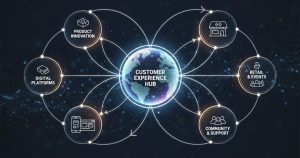Hyper-Personalized Branding: Harnessing AI and Big Data for One-to-One Customer Experiences

Generic marketing messages no longer grab attention in a crowded market. Customers now expect brands to understand their individual needs and preferences. That’s why hyper-personalized branding has become essential. Using AI, machine learning, and big data, brands can deliver tailored experiences for every customer. This approach helps businesses predict behavior, anticipate needs, and connect with audiences on a deeper level.
In this guide, you’ll discover why hyper-personalization matters, how it strengthens customer loyalty, and practical strategies to make your marketing more relevant and effective.
Why Hyper-Personalized Branding Matters
Research indicates that 80 percent of consumers are more likely to purchase from brands that offer personalized experiences. Hyper-personalization takes this further: it uses detailed customer profiles, real-time data streams, and predictive algorithms to deliver contextually relevant content, products, and offers. The benefits include:
- Increased Engagement: Customers feel understood when brands address their unique needs and preferences.
- Higher Conversion Rates: Tailored recommendations and dynamic messaging boost click-throughs and sales.
- Stronger Loyalty: Personalized journeys foster emotional connections, reducing churn.
- Competitive Advantage: Few brands execute proper one-to-one marketing at scale, so hyper-personalization becomes a differentiator.
Key Technologies Behind Hyper-Personalization

Implementing hyper-personalized branding relies on an ecosystem of advanced technologies:
- Big Data Platforms gather and store vast customer datasets from CRM systems, website analytics, social media, and IoT devices.
- Machine Learning Algorithms identify patterns, segment audiences, and predict user behaviors based on historical and real-time data.
- Natural Language Processing (NLP) analyzes customer sentiment and preferences from text, voice, and chatbot interactions.
- Dynamic Content Engines generate and personalize website copy, email subject lines, product recommendations, and ad creatives on the fly.
- API Integrations ensure data flows seamlessly across marketing automation, e-commerce, and customer service tools.
Building the Foundation: Data Collection and Management
Hyper-personalization begins with comprehensive, high-quality data. Brands must consolidate customer information into a unified profile. Key steps include:
- Integrate Data Sources: Sync CRM records, website analytics, transaction history, social media interactions, and offline touchpoints into a centralized data lake.
- Ensure Data Quality: Cleanse duplicates, validate email addresses, and standardize formats. Reliable data drives accurate personalization.
- Implement Real-Time Tracking: Use cookies, mobile SDKs, and server-side APIs to capture behaviors as they happen, enabling instant reactions.
- Maintain Privacy Compliance: Adhere to GDPR, CCPA, and other regulations. Obtain consent, anonymize PII where possible, and offer transparent opt-out options.
Crafting Dynamic, Contextual Content
Once data flows smoothly, the next step is delivering the right message at the right moment. Dynamic content engines allow brands to tailor copy, visuals, and offers based on individual profiles and context:
- Website Personalization: Swap hero images, headlines, and product grids according to browsing history and purchase intent.
- Email Customization: Personalize subject lines, greetings, and content blocks based on segment, past behavior, and predicted needs.
- Ad Targeting: Use lookalike and retargeting audiences to deliver ultra-relevant social and programmatic ads in real time.
- In-App Messaging: Trigger personalized push notifications, banners, and chat prompts based on user actions and lifecycle stage.
Predictive Modeling and AI-Driven Recommendations

Predictive analytics and recommendation engines take personalization from reactive to proactive. By analyzing patterns across millions of data points, AI can forecast customer needs before they arise:
- Product Recommendations: Suggest items that complement past purchases, fit current trends, or address identified pain points.
- Content Suggestions: Deliver blog articles, tutorials, and videos that align with a user’s interests and stage in the buying cycle.
- Churn Prediction: Identify at-risk customers and trigger retention offers or personalized outreach before they disengage.
- Lifetime Value Forecasting: Prioritize high-potential segments for VIP treatment and upsell campaigns.
Omnichannel Execution for Seamless Experiences
Customers interact with brands across multiple touchpoints: websites, email, mobile apps, social media, in-store, and call centers. True hyper-personalization requires an omnichannel approach:
- Unified Customer Profiles: Ensure every channel accesses the same real-time data, avoiding fragmented experiences.
- Consistent Messaging: Maintain tone, visual style, and value propositions across platforms, while adapting specifics to each channel’s context.
- Cross-Channel Orchestration: Coordinate campaigns so that an email offer complements a social ad, or an in-app message preludes a personalized landing page.
- Offline Integration: Link POS systems and loyalty programs to digital profiles, allowing in-store staff to deliver a consistent, personalized experience.
Ethical Considerations and Trust
Hyper-personalization walks a fine line between delighting customers and infringing on privacy. Brands must build and maintain trust by following ethical guidelines:
- Transparency: Clearly communicate how data is collected and used. Offer easy-to-find privacy policies.
- Consent Management: Implement granular opt-in controls so customers choose which data streams they share.
- Bias Mitigation: Audit AI models regularly to ensure recommendations do not reinforce stereotypes or exclude groups.
- Security: Use encryption at rest and in transit. Limit access via role-based permissions.
Measuring Success: KPIs for Hyper-Personalization
To gauge ROI, track metrics that reflect personalized engagement and revenue impact:
- Click-Through Rate (CTR) on personalized emails and ads vs. generic campaigns.
- Conversion Rate Uplift for Users Exposed to Dynamic Content vs. Control Groups.
- Average Order Value (AOV) increase driven by AI recommendations.
- Customer Lifetime Value (CLV) growth among segments receiving hyper-personalized journeys.
- Improvements in retention and churn rates through predictive outreach.
Future Trends in Hyper-Personalized Branding
The field continues to evolve rapidly. Watch for these emerging trends:
- Voice and Conversational AI delivering personalized guidance via smart speakers and chatbots.
- Augmented Reality (AR) experiences that adapt products and packaging to user preferences in real time.
- Federated Learning enables personalization without centralizing sensitive data, boosting privacy.
- Emotion AI reads facial expressions and tone of voice to dynamically adjust brand messaging.
Conclusion
Hyper-personalized branding represents the next frontier in customer experience. By integrating AI, machine learning, and big data into every customer touchpoint, brands can anticipate needs, deliver relevant messages, and build deeper loyalty than ever before. While technology is an enabler, success ultimately hinges on ethical data practices, seamless omnichannel execution, and a commitment to continuous optimization. Start small with a pilot program, measure your impact, and scale proven strategies to create one-to-one brand experiences that delight and retain customers for the long haul.
For Further Reading, explore Brand Ecosystems: How to Craft Cohesive Experiences That Engage.







